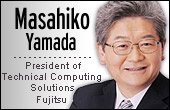Wanted: More compute power for HPCs

SINGAPORE--High-performance computing (HPC) may have come a long way since it took off 20 years ago, but despite the advancement in supercomputers' processing power, the industry is just taking its first steps in a new age of computing.

Masahiko Yamada, president of technical computing solutions at Fujitsu, explained that for the HPC industry to be able to solve "real human problems", it will need supercomputers that are "a million times faster" than the systems available today.
Speaking to ZDNet Asia in an interview here this week, he noted that the K Computer, currently the world's fastest supercomputer, is still nascent in the new computing age.
"Now, we still do not have enough power to help people," Yamada said.
For instance, he explained that while systems today can precisely simulate the impact of a tsunami at up to 5 kilometers, this needs to be improved to 50 meters. As the simulation is processed in 3D models, computing power will need to be about a million times higher than what is currently available, he said.
Nonetheless, he added that supercomputers have come a long way.
Twenty years ago, supercomputers did not have sufficient performance. Today, the processing power is a million time faster, allowing HPCs to be used to solve some human issues such as weather forecast through simulation. This makes supercomputers very relevant to the ordinary citizen, Yamada noted.
Fujitsu is currently working with Japan Meteorological Agency to help develop and support its daily operations, he said, adding that the company also provided weather data and the scale of the earthquake during the country's last major natural disaster.
He shared that, in Japan, households with televisions can get emergency updates about earthquakes which happened only seconds ago. An information feed of the earthquake's location, how strong it was, and other weather information also can be delivered to the televisions, he said.
The executive was in town to attend a private HPC workshop, organized by Singapore's Agency for Science, Technology and Research's Institute of High Performance Computing (IHPC) and Fujitsu, which gathered industry experts from Singapore and Japan.
K Computer project's bumpy start
Yamada was also part of the committee which conceived the idea behind the world's number one Japanese supercomputer, resulting in the K Computer, which topped the half-yearly Top 50 supercomputer ranking twice in 2011.
The K Computer can compute 10 quadrillion FLOPS (floating point operations per second). To help put things in perspective, he explained that this equates to a football stadium filled with 50,000 people--each of whom uses a calculator to calculate one operation per second--taking 6,340 years to complete 10 quadrillion FLOPS, which can be processed by K Computer in one second.
While the Japanese supercomputer is now the fastest system, Yamada said government funding for the project was almost terminated as the project was deemed too costly. However, in the end, the government was persuaded to keep the project, he said.
He added that the Top 500 supercomputer list does not track the actual performance of systems, but uses a simple benchmark to rank different computers.
While the ranking is useful to track trends and demonstrate the company's commitment to the HPC industry, he noted that Fujitsu's objective is use supercomputers to create new solutions that can help human lives.
"The idea cannot be realized by [Fujitsu] alone. We need the collaboration of other researchers and scientists, especially those in Asia," Yamada said, adding that the IHPC is an important partner. The two organizations had previously collaborated on developing scalable algorithms and software for petascale computing.
Ultimately, Yamada hopes to put HPCs in the hands of mainstream users and see a future where the results of supercomputer simulations can be delivered directly, in real-time, to users' handsets through cloud computing.